Het Boek. Serie 3. Jaargang 34
(1960-1961)– [tijdschrift] Boek, Het–
[pagina 210]
| |
G.I. Lieftinck
| |
[pagina 211]
| |
imposition of the sheets. It is obvious that a twelfth century copyist, who prepared his sheets and wrote his pages in this way, must have been a very strange man. But unless he was an eccentric, he must have had his reasons for doing so. In any case, it seems very interesting to see that imposition of sheets was practised as early as the twelfth century. That is to say, three hundred years before the invention of printing! It would be much more interesting, however, if what we have observed here should prove to be not an exception, but possibly a hitherto unnoticed custom in some of the mediaeval scriptoria. This remains to be investigated and confirmed by palaeographers. When, shortly after the war, I became acquainted with the Durham catalogue, I was very impressed. Professor Mynors' observations on imposition, especially, struck me, convinced as I was that a man must have had good reasons for making a book in such an extraordinary manner. A few years ago, the Leyden University Library bought a fine little bookGa naar voetnoot1. It was a small copy of the Filia magistri, a slightly modernised Epitomé of the Sententiae of Peter the Lombard, with glosses made after a commentary of Hugo de Sancto Caro by one of the latter's pupils (pl. 1). The learned Dominican, Martin, dated the work between 1232 and 1245Ga naar voetnoot2. There are more than 25 manuscripts of it in existence, each with different glosses, but it would seem that the manuscript in Leyden represents the original version and can probably be dated about 1300. It is a remarkably small book, beautifully written and marvellously preserved and it is worth noting that the book from the John Ryland's Library which had served as the starting point for Father Martin's studyGa naar voetnoot3 seems to have been very similar to it; though the Leyden copy is even smaller, with a writing space of only 7 by 4½ centimetres! Turning over the pages in order to see whether the book was complete, I found some annotations from the 16th century, pointing out a mistake in the binding of one of the quires, which are sexternions, i.e. quires of twelve leaves, 24 pages each. Substituting a sexternion of paper for the quires, I attempted by endless manipulating to bring the double-leaves of the quire into the right sequence in order to get a continuous text, but however hard I tried, I did not succeed. It had obviously not been a misbinding which had caused the disorder in the text, but some mistake on the part of a scribe, who had copied his pages in the wrong sequence. I then re- | |
[pagina 212]
| |
membered Professor Mynor's discovery. Could the text have been written on unfolded sheets, imposed in the way of a printed book? The mistake then would have been due to a wrong imposition of the text rather than to the mis-binding of the quire! In that case the scribe must have confused two of his pages, a mistake which could not be corrected. But again, why this extraordinary way of making a book? This time I thought that I really did see a clue which might help towards the solution of the problem and that clue was the exceptionally small size of the book. It must clearly have been rather difficult to have written on a very small page, and much easier to have filled in small lined columns of text, when those columns were spaced on a whole sheet. And it was then that the first meeting of palaeographers took place in Paris, that is the Colloque International de Paléographie of 1953. The president, Monsieur Samaran, the former director of the famous École des Chartes, put the following question to the members: Had any of them ever met with a ‘manuscrit imposé à la manière de la typographie’ before the period of the first printed books? I must confess that I was more than surprised. A lively discussion ensued and it turned out that this problem of the imposition of sheets had been a special concern of Monsieur Samaran for more than twenty-five years. As early as 1928 he had published his first paper on this subject in the Bulletin of the Société des Antiquaires de France. Later, just before the war, in an album presented to one of his friends,Ga naar voetnoot1 he had extended his original notes into a very interesting study, based on no less than three new discoveries which together presented irrefutable evidence of the existence of imposed manuscripts in the middle ages. Samaran had found remnants of unfolded sheets showing little columns with a written text, part of them heads-on, used by bookbinders as fly-leaves, doubtless rejected waste-sheets from various scriptoria in which this remarkable custom had been practised. They were fragments of a Book of Hours, of a Breviary, and of an Ordinary for the diocese of Coutance in Normandy - no less than fifty complete pages at a time, that is to say without doubt an abandoned altogether defective piece of work. The first specimens which came to Samaran's notice were parts of books dating from the latter part of the fifteenth century, a period in which the influence of printer's practices might at a pinch be considered possible. But more recent finds (pl. 2) make it very probable that this practice has already existed for a long timeGa naar voetnoot2. In Paris we discussed | |
[pagina *1]
| |
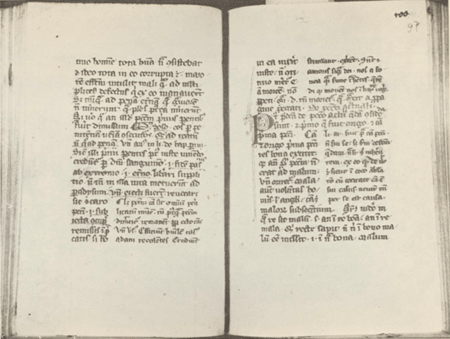 1. Filia Magistri - Leyden, Univ. Libr., ms. B.P.L. 2564, f. 96v/97r.
| |
[pagina *2]
| |
 2. ‘Imposed’ sheets from an unfinished Book of Hours (15th cent.), have recently been found as fly-leaves in a book-binding of a ms. originating from the 13th century scriptorium of the cistercian abbey of Cambron (Hainault) - The Hague, Roy. Libr. ms. 73E14.
| |
[pagina *3]
| |
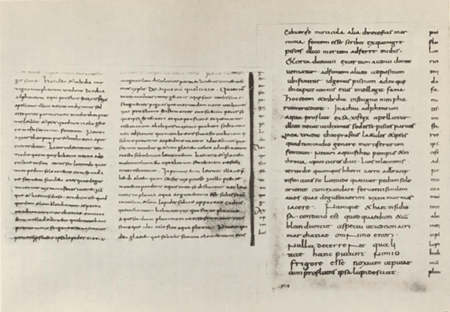 3. Leyden, Univ. Library. Left: Voss. lat. fo61, f. 98v. Right: Lips. 7, f.309va.
| |
[pagina 213]
| |
the matter over and over again, and afterwards in Leyden, and I could not but agree that all the books mentioned by the French palaeographer had this in common - they could all be considered typical mass-productions, namely Books of Hours, Breviaries, and Ordinaries of a diocese - each and every one of them compulsory reading for the clergy and finally, a Rhetorica ad Herennium, which was a well-known schoolbook. Here, in fact, is the birth of the first real mass-production of books. These manuscripts fulfilled a special need, viz. of books with the identical page numbers, containing the same text, beginning and ending each with the same word. They were made in little portable sizes and the manufacturing of them being quite simple, they must have been much cheaper than if they had been made in the normal way. This complicated system of calculating in advance the contents of every column and of planning the whole quire in its folded condition, must have been well worth the trouble, because all the subsequent copies could be slavishly copied after a pattern established once for all. Should some hundred copies of the same work be required, all things would combine to facilitate the work: the small size carried very short lines and one would therefore be practically certain that each line would contain the same number of words. It would be of great advantage to a scribe copying his model in a mechanical fashion. And then the advantage to the scribe of writing on a large sheet of parchment instead of on very small pages becomes conclusive, for this, like the other elements facilitates a kind of mass-production. But then there was mass-production of these kinds of books in the course of the fifteenth century! It was this very need for production on a large scale which led to the enormous and immediate success of printing in the fifteenth century. I found interesting proof of this on the flyleaf of one of the manuscripts in the Leyden University Library. The Leyden manuscript B.P.L. 138 is a very modest, but clearly written copy on paper, made in the year 1437 by a clerk of the diocese of Saint Malo, Jean Brulelou, as the man himself tells us carefully twice in the book.Ga naar voetnoot1 It is a schoolbook, or rather, it is a handbook for schoolmasters, and according to several annotations on the flyleaf it went from hand to hand, being sold to different clerks in the course of the fifteenth century. It then fell into the hands of a person, who must have been the director of a bookfactory, as we shall see later. The manuscript itself is remarkable because it is a manual and it was perhaps the model from which lesson-books were copied. | |
[pagina 214]
| |
It still has its original parchment-cover with the strange title Actores magni voluminis. According to Monsieur Samaran, to whom the book has been shown, the auctores octo or something similar may have been meant here, for we find some of them together in this volume. Those eight authors, well-known through several printed editions which are listed in the third volume of the Gesamtkatalog der Wiegendrucke, formed the basis of moral instruction in the mediaeval schools. Our manuscript must be such a collection of auctores, compiled for the instruction of youth. It is therefore of no small importance to find on the flyleaf of this particular ‘schoolmasters-book’, a calculation concerning the manufacturing of books in large quantities - the manufacturing of school-books. le brieut (?) que ghijs de perkement maker porta a la leye pour louvrage qui sensieut Ghijs coopt ons cc seven salmen sonder letanie ijc vlamsche cathonen cccc cleene ghebede De seve salmen het hondert v. sol. of ij sol. De cathonen C om iiij sol. of om iiij sol. vj den. [1] gr. het hondert vanden cleen ghebede xvj of xviij gr. The following is an attempt at a translation, with commentary: A certain ‘Gijs de perkament-maker’ delivers something - the word is not clear but it seems hardly too bold to presume that it was raw material that he had brought with him (parchment, as his name denotes?). - He delivers it at the Lys, a little tributary of the river Scheldt. And he buys a great quantity of books. The note is written partly in Dutch, partly in French. We are consequently on the language-frontier, and we witness here the intercourse between Flemish bookproducers and customers in Flanders, perhaps in the region of Boulogne, Saint Omer, or some such place. Literally translated the calculation reads as follows: He is buying for us 200 copies of the seven psalms without the litanies, 200 Catos in the Flemish language and 400 small prayer-books. The prices are 5 solidi or 6 solidi for a hundred copies of the psalms, 4 solidi or 4 solidi and six denaria and a penny for the Catos and 16 to 18 pennies for the small prayer-books. These are indeed all of them at the same time school-books: the seven psalms for reading-practice. ‘Vlamse cathonen’: a flemish translation of another schoolbook, the distichs of Dionysius Cato. It all goes to confirm the views of Monsieur Samaran, and forms fresh proof of the correctness of his theories.
We still have to consider the little Summa sententiarum of about 1300, however, and, last but not least, the first part of the book in the library of Durham Cathedral. Was this also mass-produced? Certainly not. The commentary of the Song of Songs is the only known copy so | |
[pagina 215]
| |
far, and the Summa, though it was probably fairly widely known at the beginning of the fourteenth century, is by no means one of the most popular of this type. It is quite impossible, therefore, to include this book in the afore-mentioned category of mass-produced books. At this point it might be useful to return to my theory concerning the difficulties of copying a very small book. Might that account for the imposition of the text in the manner of a printed book? The book is in fact a very small one, for the writingspace of its pages measures only 7 by 4½ centimetres, but one may very well compose such a book by writing it on unfolded leaves, without this complicated imposition of the text! There is after all a much easier and less cumbrous manner, as we shall see presently. In this case, however, there is yet another reason for an imposition of the text. The reproduction shows two of the pages. It is immediately noticeable that the text of this manuscript is very complicated; we see two sizes of lettering: one larger for the text of the Sententiae and the other, smaller, for the gloss. The composition of these two texts on pages of a minute size in such a way that the gloss would not be separated from the text, must have been an intricate puzzle, and it is obvious that much time must have been spent on preliminary work before the actual copying of the book. But, if we assume that the model of our manuscript had the same lay-out and more or less the same dimensions, it appears quite conceivable that the copyist could have followed closely, leaf by leaf, line by line, and even word by word, this model, lying before him. And thus we find ourselves in the same predicament as in the case of the psalters, the schoolbooks and the rest, which were mass-produced some hundred years or more after this particular book. The reasons for this method of imposing the text on whole sheets with four columns on either side before folding them were simply practical, even if a very limited number or perhaps even only one copy was planned. I have already mentioned that the idea of an imposition of the text of this manuscript occurred to me when I discovered a mistake in the continuity of the text. In trying to see what could have been the origin of this mistake, I had first of all to consider that the book had quires of twelve leaves. Its quires are sexternions instead of quaternions. The imposition of the text on the quires is therefore still more complicated. It is therefore obvious that sexternions must be made up of three sheets, each of them prepared for four columns on either side. It is, of course, possible to fold a sexternion from one single sheet, but I do not think that this has ever been done and certainly not for small quires. One has only to experiment with a sheet of thick paper - to represent parchment which is far more difficult to handle than paper - to find that one cannot fold it at right angles. | |
[pagina 216]
| |
There are two ways of copying a manuscript on unfolded sheets. The first method must have been the ordinary manner of making small books. On the scribe's desk lay four (or in the case of a sexternion, six) bifolia. Let him take for instance four bifolia, containing severally pages 1, 2, 15 and 16, pages 3, 4, 13 and 14, pages 5, 6, 11 and 12 and at last the heart of the quire, formed by the pages 7 to 10. He takes successively sheets 1 to 4 and fills their left halves, recto and verso, with the text of page 1 to 8. Then he goes to the right side of sheet four and completes the others, successively now in reverse order, filling the columns of their right halves with the text of pages 9 to 16. That is to say, what he does is simply to pursue the same course as his future reader, who will turn the pages of the quire after it has received its final folded position in the book. It is clear that an ordinary copyist can easily make a blunder. We meet with a mistake of this kind in a quire of a small manuscript on paper in the University Library at Amsterdam, written about 1490.Ga naar voetnoot1 The quire, a quaternion, shows one blank page, 11. The text goes from page 10 to 12, that is to say from one left page to the next left page. Now, two conclusions may immediately be drawn: in the first place the sheets must have been written in an unfolded condition; it is impossible that the right page 11 could have been omitted in the folded sheet. In the second place it must have been written in the way I have just described. But this book is not a manuscript with an imposed text after the fashion of a printed book either, because on an unfolded sheet which has been imposed for 16 pages, the pages 10 and 11 are neighbours. That is why it seems most unlikely that a scribe who was accustomed to making imposed manuscripts could have fallen into this error, that is to say precisely where the following part of the text is in the next column and not on another sheet, nor upside down for instance. And so, after having written page 10, that is to say the last page of the sheet in the heart of the quire with its consecutive pages 7 to 10, he had to return to sheet three again, of which the pages 5 and 6 were ready and two spaces open, meant for pages 11 and 12. It is here that he made a mistake, taking the reverse side first. This fault was irreparable. The only thing he could do was to pass over the recto and continue on the following sheet. And this is what he did. Mistakes like this are fairly common in our manuscripts; they are the cause of blank pages, indicated in the following way: hic nihil deest. But let us now return to the error made by the scribe who copied the Summa Sententiarum. He made a mistake in imposition. I will try to explain. As we have seen already - on his desk lay three sheets, each | |
[pagina 217]
| |
with a rather complicated lay-out for four columns on either side and severally situated two and two in a head-on order. As a resuit of much measuring and arranging, he had assigned the different pages of his model each to its own position, and the work of copying the text could begin at last. If this was the first copy so made from a folded quire of the model, his task must have been a heavy one. If on the other hand he worked in the manner of the book-manufacturers of some hundred years later, it must on the contrary have been very easy. For the latter worked from unfolded models which they copied without even reading the text, which made no sense anyway since there was no continuity. Whether we assume that our copyist was the first to impose his text or that he worked from imposed sheets, the error made was, nevertheless, the error of a man who had previously assigned the several pages of the original book to their positions in the system. For it is here that the mistake was made. Once at work, the scribe is no longer able to alter the sequence, and as there is here no tell-tale blank page to betray him, it has remained unnoticed for a long time. The reviser of this text did not observe the fault, or pretended not to, for the consequence would have been that the whole quire would have had to be rewritten. The mistake was quite irreparable. The reviser could very well take the risk, for who ever reads a book closely! It was not until the sixteenth century that the precious little book appears to have been thoroughly studied, and it was only then that the fault was detected. Folio 175 - or as I should rather say, the text of folio 175 - stands in the wrong place; it has been written into the columns made for folio 173. If the mysterious transposition of two pages in the Leyden manuscript would seem to have been accounted for now, there still remains Professor Mynors' puzzling twelfth century book in the Library of Durham Cathedral. This is also a small book. Its leaves, obviously uncut, measure only seven by four inches odd, and the writing space will proportionately be - let us say - about 5 by 3 inches. No wonder, therefore, that the text appears to have been written on unfolded sheets, but we do not understand why the first scribe (and he exclusively as Professor Mynors has stated), who seems to have written more carefully than the others, took the trouble to impose his text in the way of a printed book. I conclude from the catalogue that the first part of this manuscript shows regularly written pages, ruled for 24 or 25 lines. Quires have been made by severally folding two sheets which must have been eut after having been written. The last quire is a binio, a quire made by folding one single sheet. It is ciear from this that the first scribe consequently reserved three and a half quires as his part of the task. The manuscript appears to be nearly complete, because only the comment on the two last verses of the Song of Songs is wanting. It | |
[pagina 218]
| |
seems likely that the second part of the text was divided into two equal parts and given to two other scribes. Just about where we pass from one handwriting to another, in the middle of a quire, difficulties seem to have arisen: two leaves have been cut out and cancels have been laced to the stubs of the discarded leaves. This transition of hands might perhaps require a renewed inspection. However meticulous the description in a catalogue has been, there always seems to be room for fresh questions. Whatever the results of a renewed inspection of the manuscript may be, the observations on the working-method of the first scribe will always remain incontrovertable. He must have pre-calculated his portion to a nicety, for he has imposed his pages on two unfolded sheets, severally resulting in the three and a half first quaternions of the book. This only seems comprehensible if his part of the text had to fit a part which had been written already and this reminds us of very old customs in the great scriptoria of the Carolingian epoch. In relation to this I should like to turn up the fine studies of Edward Kennard Rand concerning the Vatican Livy and its model, the codex Puteanus in the National Library at Paris.Ga naar voetnoot1 Rand found out that the old manuscript, written in uncial lettering and lent by the monks of Corbie to St. Martin's of Tours, must have been resolved into quires by the leader of the Tours scriptorium. Then the latter must have distributed several packets of quires to each of his scribes, who copied them simultaneously in order to save time. It is obvious that they must have had to overcome almost insurmountable difficulties in order ultimately to obtain a continuous text. We observe that, where the several hands should connect, an irregularity in the junction occurs: either a lack of space, overcome by the continuation of the text in the margins at the end of a quire, or blank spaces testifying to the opposite. The question is, whether the Durham manuscript was possibly made in the same way. It may have been that the model was lent to the house for a very limited space of time, perhaps for one day only. In that case, it may have been taken apart and separated into several bundles of quires in order to distribute them to different scribes, appointed for the task of copying them in the short time available. The first scribe was acquainted with this sort of work and he imposed his text in the way we have become familiar with and therefore managed very well. Scribe B, less skilful than the former, copied in the ordinary way. He wrote an even smaller, faster and easier hand therefore, and so did the third scribe, both of them working with 34 to 38 lines to a page. That was their way of accelerating the work. Whatever we may think about the quality of their writing, they got the job done. Yet the way in which | |
[pagina 219]
| |
they linked their texts together is still not quite clear. A fresh study of the book might result in a clearer picture of the situation. At all times the contriving of good junctions in a text, however, was the main problem of mediaeval scribes. In conclusion I should like to comment on some pages of two manuscripts in the Leyden University Library of which the one is a direct copy of the other. I mean the Vossianus and the Lipsianus of Pliny the Elder, both well-known through the beautiful plates published by Chatelain.Ga naar voetnoot1 The dates given here, however, would seem to be incorrect, according to the recent studies of Lowe and Bischoff. The first manuscript, a beautiful copy from the scriptorium of Corbie, or very closely related to Corbie, according to the script, and to be dated in the very end of the eighth century, was copied at the beginning of the ninth, at another, less prominent centre, by different scribes simultaneously. Here also the model was taken apart, one or two quires at a time, and distributed to different copyists. Most of them met with difficulties in establishing a satisfactory link with the next quire, which was being copied by another scribe at the same time. One of them was a rather meticulous man. In order to avoid mistakes, he decided to copy his model slavishly, column by column, and it is here that we witness the first steps towards the system of the imposition of a text. For safety's sake, he first of all copied the beginning of each column which has to be filled with written text, and subsequently tried to spread the text of his model evenly over the much larger space of his own column. I have to add here, that the later manuscript is of quite different dimensions: namely a large folio, adapted, consequently, by the leader of the scriptorium, to the much bigger and clumsier script of his less skilful copyists. It is agreeable indeed to see how the precautions of our man were rewarded by ultimate success. Only once did he make a mistake. He had not seen that the columns of one of the pages of his model had been very carelessly prepared: the first column was much narrower than the second one. Plate 3 shows clearly what happened at this point. In this way the collaboration of several scribes led to the precalculation of the writing-space on the sheets, that is to say, to the first steps in the imposition of texts. Real imposition, in the manner of printed books, would appear to have been reserved only for small books. It seems that although a slavish copying of a very complicated lay-out of the model was the obvious way to a good result, an imposition of the text was sometimes practised. Only one manuscript of this sort has been found as yet. In this connection it would be extremely | |
[pagina 220]
| |
interesting in the connection to study all the manuscripts described in our catalogues as misbound. Many of them might indeed show mistakes in imposition rather than in the binding.
Leyden, Warmonderweg 17. | |
[pagina *5]
| |
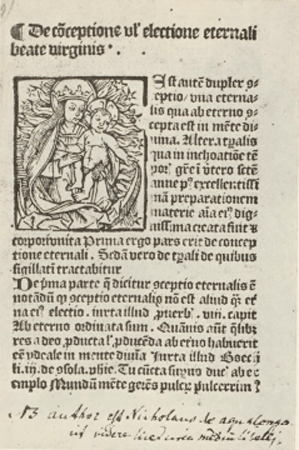 I. Joh. Paltz, De conceptione... b. virginis, bl. 1 a
| |
[pagina *6]
| |
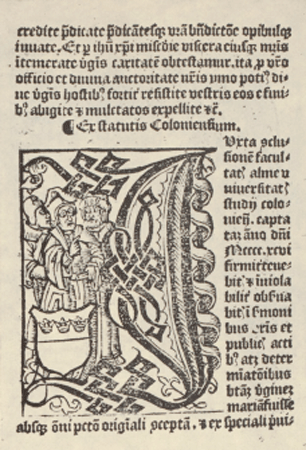 II. Joh. Paltz, zelfde werk, bl. 18 b
| |
[pagina *7]
| |
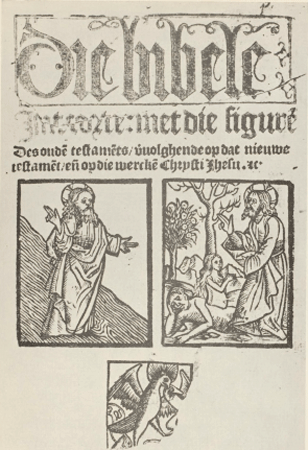 III. Die bibele int corte, titelblad
| |
[pagina *8]
| |
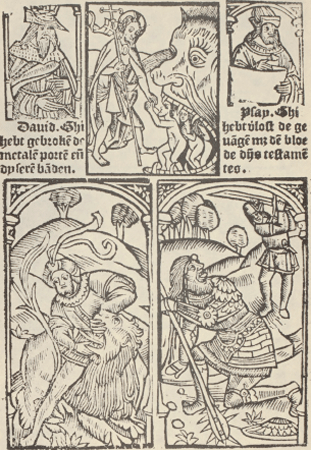 IV. Die bibele int corte, bl. 33 b
| |
[pagina *9]
| |
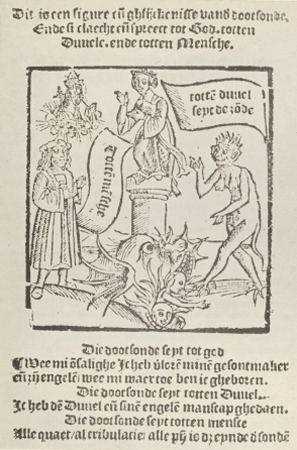 V. Die bibele int corte, bl. 55 b
|
|

